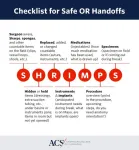EMBARGOED FOR RELEASE UNTIL 4 P.M. ET, WEDNESDAY, JUNE 19, 2024
MINNEAPOLIS – Certain drugs used to treat urinary symptoms due to an enlarged prostate may be associated with a reduced risk of dementia with Lewy bodies, according to a study published in the June 19, 2024, online issue of Neurology®, the medical journal of the American Academy of Neurology. Dementia with Lewy bodies is a progressive neurodegenerative disorder that can cause memory and thinking issues, movement problems and issues such as hallucinations.
The results do not prove that these drugs reduce the risk of dementia with Lewy bodies; they only show an association.
“These results are exciting because right now there are no drugs to prevent or treat dementia with Lewy bodies, which is the second most common neurodegenerative type of dementia after Alzheimer’s disease,” said study author Jacob E. Simmering, PhD, of the University of Iowa in Iowa City. “If we can determine that an existing drug can offer protection against this debilitating disease, that has the potential to greatly reduce its effects.”
The study looked at male participants taking different types of drugs to treat urinary problems caused by an enlarged prostate, a common problem for older men. The drugs terazosin, doxazosin and alfuzosin could block brain cell death by activating an enzyme important for energy production in brain cells. Previous studies have shown an association between these drugs and Parkinson’s disease, which is similar to dementia with Lewy bodies.
For the study, researchers looked at a health information database for male participants who had started taking one of those three drugs. They were compared to people who took two other types of prostate drugs that do not activate the same enzyme—tamsulosin and the 5α-reductase inhibitors finasteride and dutasteride, called 5ARIs.
Overall, there were 126,313 people taking terazosin, doxazosin or alfuzosin, 437,045 people taking tamsulosin and 80,158 people taking a 5ARI. Researchers followed the participants for an average of three years to see who developed dementia with Lewy bodies.
There were 195 people who developed the disease among those taking terazosin, doxazosin or alfuzosin, for a rate of 5.21 cases per 10,000 people per year. Among those taking tamsulosin, there were 1,286 cases, for a rate of 10.76 per 10,000 people per year. Among those taking 5ARIs, there were 193 cases, for a rate of 7.78 per 10,000 people per year.
Once researchers matched the groups by age, other health conditions and other factors that could explain the differences between groups, they found that people taking terazosin, doxazosin or alfuzosin were 40% less likely to develop dementia with Lewy bodies than people taking tamsulosin and 37% less likely than people taking the 5ARIs. The risk of developing the disease was similar among those taking tamsulosin and the 5ARIs.
“More research is needed to follow people over time and determine whether there is a cause-and-effect relationship here, but it is promising to think that these drugs could have a protective effect on this disease that will likely affect a larger number of people as the population ages,” Simmering said.
Since only male participants were included in the study, the results may not apply to female participants. Another limitation of the study is that dementia with Lewy bodies can be difficult to diagnose, so it’s possible that not all people with dementia with Lewy bodies were correctly diagnosed.
Learn more about dementia with Lewy bodies at BrainandLife.org, home of the American Academy of Neurology’s free patient and caregiver magazine focused on the intersection of neurologic disease and brain health. Follow Brain & Life® on Facebook, X and Instagram.
When posting to social media channels about this research, we encourage you to use the hashtags #Neurology and #AANscience.
The American Academy of Neurology is the world's largest association of neurologists and neuroscience professionals, with over 40,000 members. The AAN’s mission is to enhance member career fulfillment and promote brain health for all. A neurologist is a doctor with specialized training in diagnosing, treating and managing disorders of the brain and nervous system such as Alzheimer's disease, stroke, concussion, epilepsy, Parkinson's disease, multiple sclerosis, headache and migraine.
For more information about the American Academy of Neurology, visit AAN.com or find us on Facebook, X, Instagram, LinkedIn and YouTube.
END
Common prostate drugs tied to lower risk of dementia with lewy bodies
2024-06-19
(Press-News.org)
ELSE PRESS RELEASES FROM THIS DATE:
Drugs for enlarged prostate may also protect against dementia with Lewy bodies
2024-06-19
A new study suggests that certain drugs commonly used to treat enlarged prostate may also decrease the risk for dementia with Lewy bodies (DLB). This observational finding may seem surprising, but it mirrors previous work by the University of Iowa Health Care team that links the drugs to a protective effect in another neurodegenerative condition–Parkinson's disease.
The UI researchers think that a specific side effect of the drugs targets a biological flaw shared by DLB and Parkinson’s disease, as well as other neurodegenerative ...
Titan’s lakes may be shaped by waves
2024-06-19
Titan, Saturn’s largest moon, is the only other planetary body in the solar system that currently hosts active rivers, lakes, and seas. These otherworldly river systems are thought to be filled with liquid methane and ethane that flows into wide lakes and seas, some as large as the Great Lakes on Earth.
The existence of Titan’s large seas and smaller lakes was confirmed in 2007, with images taken by NASA’s Cassini spacecraft. Since then, scientists have pored over those and other images for clues to the moon’s mysterious ...
YALE EMBARGOED NEWS: Family psychiatric history: Effects on siblings of children with autism
2024-06-19
New Haven, Conn. — Children who have an older sibling with autism spectrum disorder (autism) are at greater risk of developmental vulnerabilities if they also have other relatives with neurodevelopmental or psychiatric conditions, according to a new study from the Yale Child Study Center.
Researchers found that the siblings of children with autism had an increase in the severity of social and communication difficulties — which are common in autism — if they had relatives with conditions such as schizophrenia or anxiety. Family histories of anxiety and intellectual disability were also associated ...
New technology provides electrifying insights into how catalysts work at the atomic level
2024-06-19
A team led by Lawrence Berkeley National Laboratory (Berkeley Lab) has invented a technique to study electrochemical processes at the atomic level with unprecedented resolution and used it to gain new insights into a popular catalyst material. Electrochemical reactions – chemical transformations that are caused by or accompanied by the flow of electric currents – are the basis of batteries, fuel cells, electrolysis, and solar-powered fuel generation, among other technologies. They also drive biological processes such as photosynthesis ...
Researchers create new class of materials called ‘glassy gels’
2024-06-19
Researchers have created a new class of materials called “glassy gels” that are very hard and difficult to break despite containing more than 50% liquid. Coupled with the fact that glassy gels are simple to produce, the material holds promise for a variety of applications.
Gels and glassy polymers are classes of materials that have historically been viewed as distinct from one another. Glassy polymers are hard, stiff and often brittle. They’re used to make things like water bottles or airplane windows. Gels – such as contact lenses – contain liquid and are soft and stretchy.
“We’ve created a class of materials ...
Tabulae Paralytica: Mapping the biology of spinal cord injury in unprecedented detail
2024-06-19
Scientists at EPFL have achieved a significant research milestone in the field of spinal cord injuries—mapping out the cellular and molecular dynamics of paralysis in unprecedented detail with their open-source project 'Tabulae Paralytica'. Grégoire Courtine and his team have integrated cutting-edge cell and molecular mapping technologies with artificial intelligence to chart the complex molecular processes that unfold in each cell after spinal cord injuries (SCI). Published in Nature, this seminal ...
When in drought: Researchers map which parts of the Amazon are most vulnerable to climate change
2024-06-19
In the late 2000s, Scott Saleska noticed something strange going on in the Amazon rainforest.
In 2005, a massive drought struck the region. Two years later, Saleska – a University of Arizona professor in the Department of Ecology and Evolutionary Biology – published surprising research that used satellite images to find that the drought resulted in more green growth in large swaths of the Amazon. On the other hand, field researchers saw plants brown and some die in response to the drought.
Research published today in the journal Nature reveals what caused the scientific mismatch. Shuli Chen, a doctoral degree candidate in ecology and evolutionary ...
Standardized OR handoffs significantly improve surgical communication and patient safety
2024-06-19
Key Takeaways
The introduction of a standardized handoff protocol substantially improved communication among OR staff, ensuring critical information was transferred consistently.
The enhanced communication reduced potential patient safety risks and highlighted the importance of standardized handoff tools in improving surgical outcomes.
CHICAGO (June 19, 2024) — A new study showcases a successful quality improvement program that significantly enhances surgical safety. By implementing a standardized handoff protocol, known as SHRIMPS, the study demonstrates how ...
Immune response study explains why some people don't get COVID-19
2024-06-19
Scientists have discovered novel immune responses that help explain how some individuals avoid getting COVID-19.
Using single-cell sequencing, researchers from the Wellcome Sanger Institute, University College London (UCL), Imperial College London, the Netherlands Cancer Institute and their collaborators, studied immune responses against SARS-CoV-2 infection in healthy adult volunteers, as part of the world's first COVID-19 human challenge study1. Not all exposed participants went on to develop a COVID-19 infection, ...
New research illuminates the ecological importance of gray wolves in the American West
2024-06-19
Corvallis, OR — A study published today in the journal BioScience sheds light on the importance of gray wolves in western United States. Led by William Ripple, a scientist at Oregon State University and the Conservation Biology Institute, the research delves into the implications of large predator absence on plant and animal communities, and ecosystem functions. It calls attention to “shifting baselines” wherein increasingly degraded conditions are viewed as reflecting the historical state of a system.
"By the 1930s, wolves were largely absent from the American West, including its national parks. Most published ecological ...







